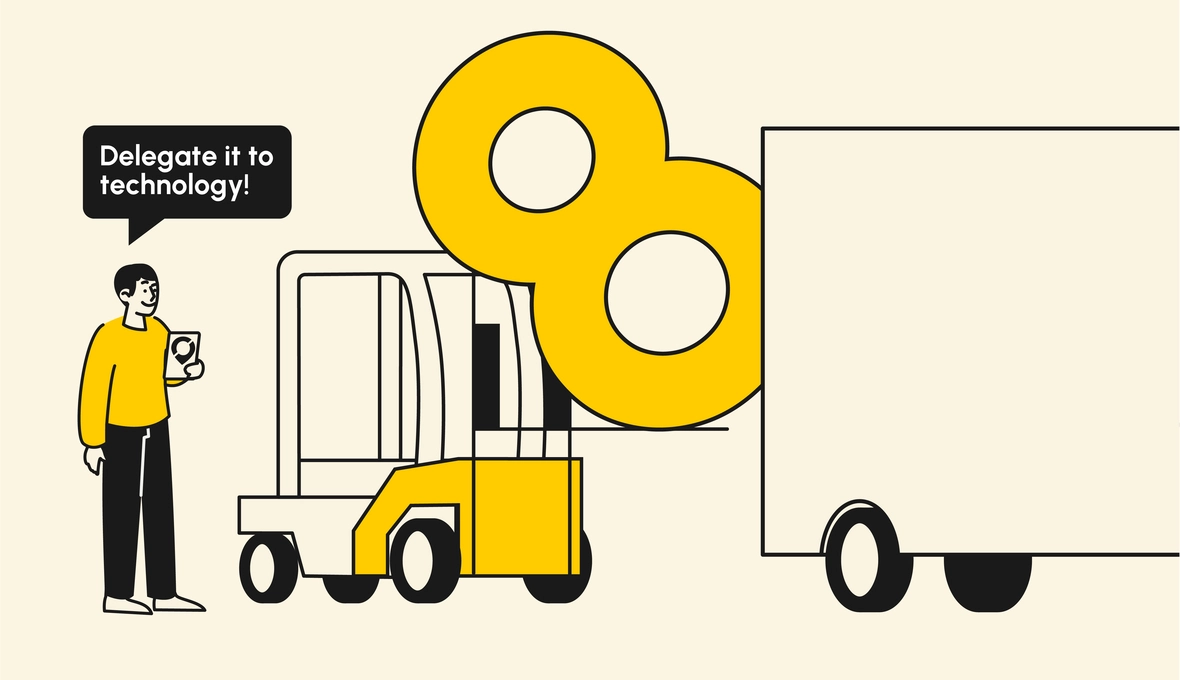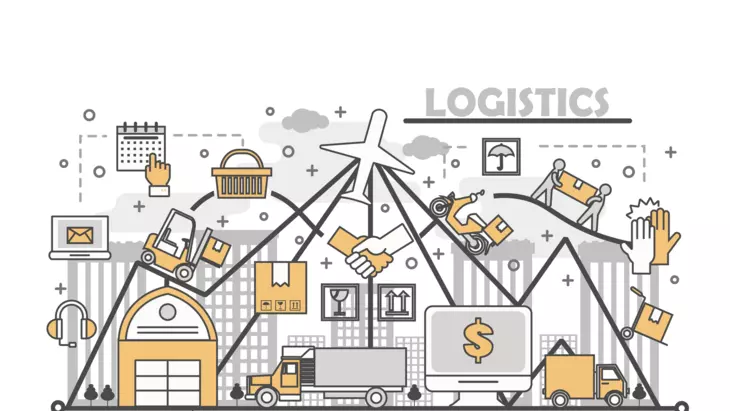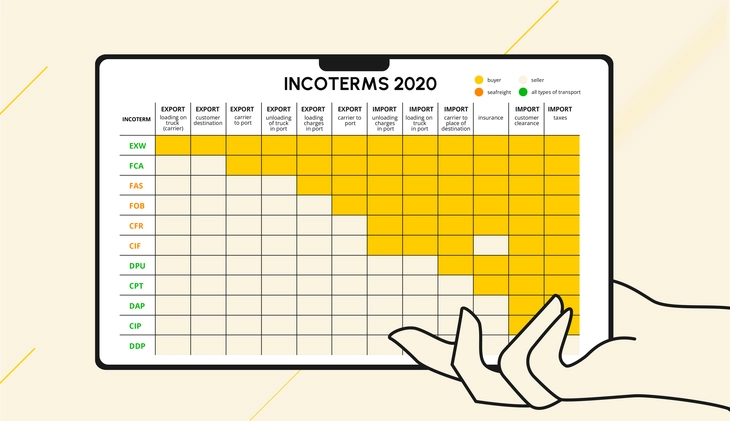Unustage rutiinsed tegevused - delegeerige need tehnoloogiale!
Siin on mõned igapäevased logistikaülesanded, mida saate hõlpsasti automatiseerida.
Logistika, eriti transpordikorralduse osa sellest, on üks neid valdkondi, mis pole tehnoloogia arenguga seni veel sammu jõudnud pidada. Kui kaubatranspordi korraldamine on üks teie igapäevastest kohustustest, siis võib rutiinsete tegevuste automatiseerimine anda teile nii palju lisa tööaega, et teie ettevõtte arengupotentsiaal mitmekordistub.
Me oleme koostanud nimekirja logistikaülesannetest, mida saab tänapäeval juba hõlpsasti tehnoloogiale usaldada.
Siin on mõned igapäevased logistikaülesanded, mida saate hõlpsasti automatiseerida.
Logistika, eriti transpordikorralduse osa sellest, on üks neid valdkondi, mis pole tehnoloogia arenguga seni veel sammu jõudnud pidada. Kui kaubatranspordi korraldamine on üks teie igapäevastest kohustustest, siis võib rutiinsete tegevuste automatiseerimine anda teile nii palju lisa tööaega, et teie ettevõtte arengupotentsiaal mitmekordistub.
Me oleme koostanud nimekirja logistikaülesannetest, mida saab tänapäeval juba hõlpsasti tehnoloogiale usaldada.
1. Oma klientide, äripartnerite ja kolleegide informeerimine transpordiga seotud asjaoludest
Ennevanasti:
- Te logite sisse ühe või mitme logistikateenuse pakkuja veebisaidile ja koostate oma veotellimused.
- Te avate oma postkasti ja saadate oma kliendile e-kirja, et teavitada neid saadetise eeldatavast kättesaamise kuupäevast.
- Mõne aja pärast aga saate oma äripartnerilt telefonikõne või e-kirja küsimustega: Kui kaugel kaup on? Mis on saabuva veoki number?
- Teie saadate küsimused edasi oma veofirmale.
- Mõne aja pärast saate veofirmalt vastused ja edastate need oma kliendile.
Tänapäeval:
- Te logite sisse oma universaalsesse veohaldustarkvarasse ja teete veotellimuse.
- Teie äripartnerile saadetakse automaatselt teavitus eeldatavate tarnekuupäevade ja saadetise jälgimise lingiga.
- Kui teie veofirma annab teada tarneaja muutusest või veoki registreerimisnumbrist, siis vastavalt seadistustele saavad automaatse teavituse ka teie äripartnerid.
2. Transpordivajaduse teavitus teie müügijuhtide, ostujuhtide ja logistiku vahel
Teil on üks või mitu logistikut ja terve meeskond müügimehi. Müügi- või ostujuhtidel on igapäevaselt vaja tellida kauba transport. Logistikajuhi ülesanne on koguda kokku kõik transpordivajadused ja korraldada transport.
Ennevanasti:
- Müügi- või ostujuhid saadavad e-kirja või helistavad logistikajuhile ja annavad teada oma transpordivajadustest.
- Logistikajuht koostab veovajaduste nimekirja, otsustab, millist vedajat igaühe puhul kasutada ning korraldab transpordi erinevates vedajaportaalides või siis e-kirju laiali saates.
- Logistikajuht on nagu orav rattas, kes vahendab teavet oma kolleegide ja veofirmade vahel.
Tänapäeval:
- Kõik ettevõtte müügi- ja ostujuhid sisestavad oma transpordivajadused ühtsesse süsteemi.
- Logistikajuht näeb uusi transpordivajadusi oma töölaual, kus on koheselt ka kõik otsustamiskriteeriumid (veohinnad, tarneajad ja isegi CO2 eelkalkulatsioon). Logistikajuht teeb parima valiku vaid ühe klikiga.
- Info saadetise liikumise kohta muutub reaalajas ja seda otse müügi- või ostujuhtide endi silme ees.
3. Erinevate veofirmade iseteenindusportaalide kasutamine
Ennevanasti:
- Oletame, et teil on 6 erinevat veofirmat, kellega teie ettevõte töötab: vedaja A, B, C, D, E ja F.
- Siseriiklike väikepakkide saatmiseks logite sisse vedaja A süsteemi.
- Rahvusvaheliste väikepakkide puhul logite sisse vedaja B süsteemi.
- Riigisisese maanteekaubaveo jaoks ei ole vedajal C veebipõhist iseteenindusportaali, seega saadate transpordi tellimiseks kindlale inimesele e-kirja, ja seda vastavalt veosuunale.
- Rahvusvahelise maanteekaubaveo jaoks logite sisse kas veofirma D või veofirma E süsteemi, olenevalt lähte- või sihtkohast.
- Meretranspordi jaoks logite sisse veofirma F süsteemi.
Tänapäeval:
Kasutades universaalset veohaldustarkvara on transpordi tellimise protsess täpselt ühesugune mis tahes vedajaga, kellega koos töötate. Vedajad saavad teie veotellimuse olenevalt enda IT-võimekusest ja eelistustest kas otse oma tarkvarasse või automaatse e-kirja teel. Seadistused on eelnevalt tehtud ja tarkvara kasutaja ei pea tehniliste üksikasjade pärast muretsema.
4. Töötajate koolitamine koostööks erinevate veofirmadega
Ennevanasti:
- Uus aasta on kätte jõudnud ja olete otsustsanud vahetada välja mõne oma logistikateenuste pakkujatest. See tähendab, et peate kindlasti end uue veofirma tarkvaraga eelnevalt kurssi viima ja oma meeskonda koolitama.
- Kui teie meeskonda tuleb uus liige, siis ta vajab koolitust erinevate veofirmade tarkvarasüsteemide kasutamiseks. Te peate kõigis süsteemides oma paroole jagama või looma neile uued kontod.
- Samuti vajavad uued inimesed täpset infot kõigist teie veofirmadest, ekspedeerijatest ja kliendihalduritest, kellega transporditellimuste, hinnapäringute ja muudatuste osas ühendust võtta.
Tänapäeval:
- Teie ettevõte kasutab universaalset kaubaveohaldustarkvara ja seetõttu ei too logistikateenuse pakkuja vahetamine teie töövoogu kaasa mitte mingeid muudatusi.
- Te koolitate uusi meeskonnaliikmeid kasutama ainult ühte süsteemi, ja mitte enam kümmet erinevat.
- Kõik teile olulised kontaktid on eelseadistatud ja leitavad automaatselt iga saadetise ja vedaja kohta.
5. Enne puhkusele minekut peavad sinu kolleegid olema kursis sinu tegemistega
Ennevanasti:
Plaan on puhkusele minna, kuid kõigepealt peate oma kolleegi hetkel töösolevate ja tulevaste saadetistega kurssi viima. Kuna saadetiste info on erinevates vedajasüsteemides, sinu isiklikus postkastis ja Exceli tabelis, siis on see üleandmine enamasti üks suur väljakutse. Ootamatu haiguse korral aga sootuks võimatu.
Tänapäeval:
Teie kolleeg logib sisse teie ettevõtte kaubaveohaldustarkvarasse. Kuna ühtne töölaud uueneb automaatselt, siis on info kõikide saadetiste kohta kindlasti ajakohane ja sa saad rahulikult puhkusele minna.
Tänapäeval:
Teie kolleeg logib sisse teie ettevõtte kaubaveohaldustarkvarasse. Kuna ühtne töölaud uueneb automaatselt, siis on info kõikide saadetiste kohta kindlasti ajakohane ja sa saad rahulikult puhkusele minna.
6. "Kui palju see kaubavedu maksma läheks?"
Oletame, et teie ettevõttel on koostööleping 5 erineva vedajaga. Teil on tarvis saadetis teele panna ja te peate valima õige vedaja vastavalt kaubakogusele ja veosuunale.
Ennevanasti:
Ennevanasti:
- Teie ettevõttel on kõigi oma vedajatega eelnevalt kokku lepitud veohinnakirjad. Teil on need kas välja prinditud või PDF/Excel vormingus oma arvutis.
- Te arvutate välja saadetise transpordikaalu ja kehtiva hinna leidmiseks vaatlete kõiki hinnakirju.
- Lisaks peate veofirmade veebilehtedelt kontrollima kehtivaid kütuselisatasusid (BAF).
- Arvestustulemuste põhjal saate pingerea ja teete valiku oma parimate vedajate hulgast.
Tänapäeval:
Te laadite oma eelnevalt kokku lepitud hinnakirjad veohaldustarkvarasse, mis suudab neid hinnakirju automaatselt töödelda ja lugeda. Kõik saadetisepõhised arvutused ja võrdlused on hetkega teie ja teie kolleegide silme ees. Läbipaistev lahendus säästab teile palju aega ja raha.
7. Transpordiinfo copy/paste ühest tarkvarast teise
Ennevanasti:
- Teie ettevõtte kasutab mingit kindlat majandus- või finantstarkvara (ERP). Transpordi tellimisel kopeerite saadetise info ERP-ist oma logistikateenuse pakkuja tarkvarasse või siis veotellimuse e-kirja.
- Seejärel kopeerite ehk ka mingi info veofirma tarkvarast tagasi oma majandustarkvarasse.
- Teil võib olla ka veebipood, kuhu ostja poolt kord juba sisestatud info tuleb taaskord copy/paste meetodit kasutades veofirmale saata.
Tänapäeval:
- Teie ERP, veebipood või ladu on integreeritud teie kauba veohaldustarkvaraga. Te saate automaatselt või siis paari klikiga saata transporditellimusi otse ERP-ist ükskõik millisele oma vedajale ja saada automaatselt tagasi kogu vajaliku teabe (pakisildid, jälgimisnumbrid jne).
- Teie veebipood on integreeritud teie ERP-ga. Nüüd saate kasutada oma ERP tarkvara ka transporditellimuste ühtse allikana või lihtsalt sünkroonida teavet veebipoega.
8. Tervet ettevõtet hõlmav veoteenuste statistika
Ennevanasti:
- Teie ettevõtte saadetiste ajalugu ja statistika on erinevate logistikateenuste pakkujate süsteemide vahel laiali. Mõnel väiksemal, kuid siiski väga tublil teenusepakkujal, ei pruugi statistikamoodulit üldse ollagi.
- Tervet ettevõtet hõlmavaks aruandeks ekspordite esmalt algandmed erinevate veofirmade süsteemidest. Seejärel töötlete neid Excelis, misjärel saate hakata andmetest endale vajalikku statistikat genereerima. Kuna see töö on väga ajamahukas, siis pahatihti jääb see üldse tegemata.
Tänapäeval:
Kogu teie saadetiste ajalugu ja statistika on hõlpsasti kättesaadav teie veohaldustarkvarast, olenemata vedajast. Te saate kasutada kas eelnevalt loodud aruandeid või siis paari klikiga eksportida vajalikud algandmed ja luua oma aruanne vastavalt vajadusele.
Seega need on 8 asja, mis võivad teie päevast liiga palju aega võtta.
Parim osa? Cargoson saab seda kõike automatiseerida ja veel palju muud teie heaks teha!
Uuri mida kasutajad Cargosonist arvavad
või
võta Cargoson kasutusele






